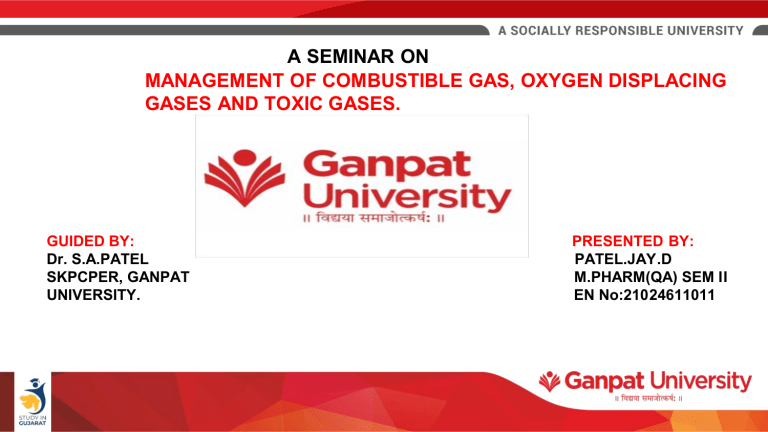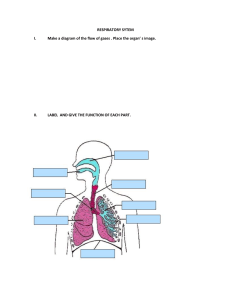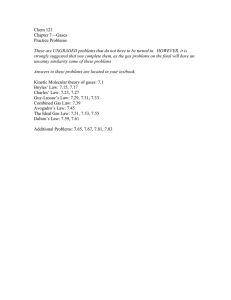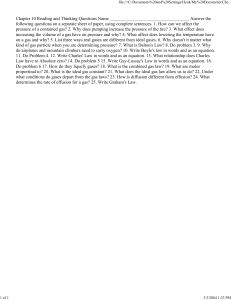Gas Management Seminar: Combustible, Toxic, Oxygen Displacing
advertisement

A SEMINAR ON MANAGEMENT OF COMBUSTIBLE GAS, OXYGEN DISPLACING GASES AND TOXIC GASES. GUIDED BY: Dr. S.A.PATEL SKPCPER, GANPAT UNIVERSITY. PRESENTED BY: PATEL.JAY.D M.PHARM(QA) SEM II EN No:21024611011 CONTENT Combustible gas: Definition Examples How to manage combustible gases Toxic gas: Definition Examples How to Manage toxic gases Oxygen displacing gas: Definition Examples REFERENCES COMBUSTILE GASES ● ● ● ● Combustible gas is one that will burn when mixed it with oxygen and ignited. Combustible gas-air mixtures can be burned over a wide range of concentrations. The actual minimum concentration varies from about 0.5% to about 15% by volume in air for most common CHCs. Examples; Ammonia, Benzene, Methane, Hexane, Heptane, Pentane, Butane, Propane, Ethane, Ethylene, Isobutylene, Propylene, Iso-butane, Isopentane, Hydrogen. Lower flammable limit(LFL) is different for different gases. LFL means specific concentration above which an ignition source will cause an explosion. HOW TO MANAGE COMBUSTIBLE GASES 1. 2. Work procedure and training: Storage, dispensing, use and maintenance of engineering controls used in the work place such as; ventilation. Required PPE for handling flammable products, fire protection and prevention. Special circumstances like; hot work which may requires additional precautions and training. Storage of combustible gases: Store flammable gas cylinders in a separate ventilated room and do not store with oxygen cylinders, electrical or heating equipment, near exits side. Ensure that cylinders are properly secured so that they can’t fall over and valves protected from damages. 3. 4. Always use correct fittings and valves for the specific cylinder, do not mix and match fittings. Protect hoses, connections and containers from damage and inspect them regularly. Limit the amounts of flammable materials: Purchase gas containers in smallest volume. Keep that gas containers when we need on-site work. At work places, keep those chemicals that are needed for present task. Keep flammable materials separate from other processes and storage areas. Control ignition sources: Never store flammable materials near hot equipments or open flames. Ensure that there is no smoking in work areas where flammable material are stored. Use intrinsically and non-sparking tools. TOXIC GASES ● ● ● ● ● Toxic gases (or noxious gases) are gases that are harmful to living things. They can easily build up in confined working spaces when the production process uses noxious gases. It may also result in the biological chemical breakdown of a substance that is being stored in a tank. Certain factory-related activities. such as welding, can also result in the buildup of toxic gases in a confined space. Examples: Bromine, Chlorine, Carbon monoxide(CO), Diazomethane(N2CH2), Phosphine(PH3), Phosgene(OCl2), Sulfur tetra fluoride(SF4), PF5, OS2, OF2, NO2, Hydrogen azide, Isocyanide and cyanide. HOW TO MANAGE TOXIC GASES 1. 2. Emissions of toxic gases come in diverse forms depending on the sources the emission. When selecting the collection methods for polluted gases. It is necessary to take into consideration the properties of gases and same time taking into facility site, surrounding environment and economical efficiency. Fume hood: Be certified for chemical use by EHS(Environment, Health and Safety) within year (as indicated by a certification sticker on the fume hood). Have airflow measuring devices and visual and audible alarms that signify low airflow conditions, Be located in rooms that are exhausted and negative in pressure to surrounding areas. 3. 4. Handlings: Proper personal protection equipment (PPE) must be worn at all times to prevent eye and skin contact, No work with toxic or highly toxic gases shall be performed alone, Material Safety Data Sheets (MSDS) must be reviewed prior to working with any toxic or highly toxic gas. Standard Operating Procedures (SOP) must be developed for the gases in use; the University’s PHS(Particularly hazardous substances) procedure format may be used. Storage: Cylinders must be stored in a well ventilated area, protected from the weather. Cylinders should be stored in locations appropriate for compressed gas storage and separated from incompatible compounds by a distance of not less than 20 feet. 5. 6. Piping, tubing, valves and fittings: It will be designed and fabricated from materials compatible with the material to be contained and shall be of adequate length and durability to withstand the pressure and structural stress. It has emergency shutoff valves identified and the location shall be clearly visible and indicated by means of a sign. Gas cabinets: Have self-closing doors, Be constructed of not less than 12 gauge steel, Have airflow measuring devices and visual and audible alarms that signify low airflow conditions. Be located in rooms that are exhausted and negative in pressure to surrounding areas. Have self-closing limited access ports or non-combustible windows to give access to equipment controls. OXYGEN DISPLACING GASES ● ● ● ● It is a gas that reduces or displaces the normal oxygen concentration in breathing air. Exposure for prolonged periods of oxygen depleted air will lead to death by suffocation. Asphyxiant gases in the breathing air are normally not hazardous. Only where elevated concentrations of Asphyxiant gases displace the normal oxygen concentration does a hazard exist. Example; Methane, Nitrogen, Argon, Helium, Butane and Propane and along with Carbon dioxide and Ozone. ● ● The risk of breathing asphyxiant gases is frequently underestimated leading to fatalities, typically from breathing helium in domestic circumstances and nitrogen in industrial environments. The term asphyxiation is often mistakenly associated with the strong desire to breathe that occurs if breathing is prevented. This desire is stimulated from increasing levels of carbon dioxide. However, asphyxiant gases may displace carbon dioxide along with oxygen, preventing the victim from feeling short of breath. In addition the gases may also displace oxygen from cells, leading to loss of consciousness and death rapidly. REFERENCES ● ● ● ● ● ● ● https://www.cmu.edu/ehs/Laboratory-Safety/chemical-safety/documents/ehs---toxic-andhighly-toxic-gas-handling-procedure.pdf / May 2022. https://www.safeopedia.com/definition/2337/toxic-gas/ May 2022. https://www.env.go.jp/earth/coop/coop/document/01-apctme/01-apctme-0710.pdf/ May 2022 https://www.lindegas.com/en/images/Hazards%20of%20inert%20gases%20and%20oxygen%20depletion_tcm 17-13909.pdf/ May 2022. https://ohsonline.com/Articles/2004/07/Flammable-and-Combustible-Materials.aspx/ May 2022. https://www.uregina.ca/hr/hsw/assets/docs/pdf/Employee-Safety/Handling-and-Storage-ofFlammable-Materials.pdf/ May 2022. https://controlequipment.com.au/combustible-gases/ May 2022.



